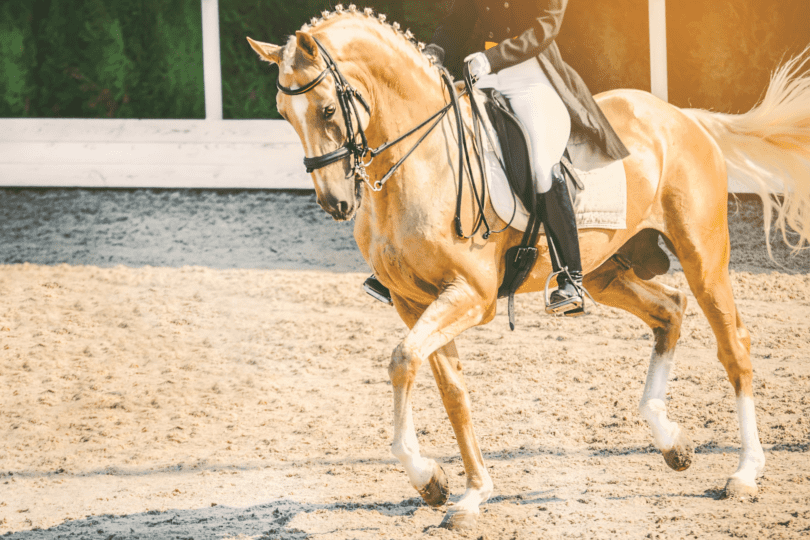Legs, hands, and seat, oh my!
The Circle of the Aids is a wonderful concept in Dressage, but one that is seldom discussed and even more seldom taught.
It is a principle that is in constant flux, yet can create stability between the horse and the rider at every step of the training.
The concept applies to nearly every discipline, yet few riders discuss it outside of the
Visualize your energy flow
Per
New to the sport? Check out our 27-Page Horse Rookie’s Guide to Dressage.
Photo: Stephany Fish
As a
For me, the Circle of the Aids starts with the rider’s understanding of exactly what their aids should do.
Tired of average tests? Learn how to improve your dressage scores.
How to use your legs in dressage
The leg (from the knee down) creates the energy, motion, power that we need from the hind legs of the horse.
Think of your legs like the pull cord to the motor on the boat motor or lawn mower.
Without the lower leg saying GO (and getting a good answer!), we cannot begin to use the Circle of the Aids because there is nothing to power its cycle.
Photo: Stephany Fish Crossman
How to use your hands in dressage
The hand (from the elbow to the bit), attached to the rein and therefore to the bit, receives and recycles the energy created by your legs. It directs the power, and without it we would have a lot of horses running on the forehand, all strung out. (It is incidentally a length of rein thing, as the Circle of the Aids can be used at all levels of Dressage, and quite successfully used in other arenas.)
Photo: Stephany Fish Crossman
What we want to focus on is the quality of the “catch of the hand” in answer to the power of the leg. Notice that I used the word receive – quite a different concept than the word pull.
Here are two analogies I like to use to help students grasp the concept of receiving versus pulling:
- Motor Boat: Imagine the motorboat again, but without the motor started. You can stand at the wheel, turn, and pull on it, but nothing will happen. Once the motor is started, though, your hand can quite easily steer the wheel and make use of the power the motor creates to make the boat move.
- Air Conditioning: Imagine turning on the air conditioning in your house (or heat for Northern folks without air conditioning!). A poor connection to the hand, such as a rein that is too long or an open hand, is like propping the front door open. The A/C unit keeps on creating cold air, but all that wonderful cold air rushes out the open door — diluting and wasting it. Conversely, a pulling hand is like turning the unit on and then putting a piece of furniture in front of it – the unit works and works, but the air cannot get anywhere because it is blocked from circulating.
New to the sport? Check out our 27-Page Horse Rookie’s Guide to Dressage.
How to use your seat in dressage
Finally, energy cycles through the seat, which consists of everything from your knee up your leg, to your bottom, up your back, and down your arm to your elbow. While being the most talked about aid, the Seat is also the most confusing aid. It seems to be gifted magical powers of epic proportion when it comes to properly organizing a horse.
Photo: Stephany Fish Crossman
I call the seat the “Condiment Aid” — yes, like ketchup or mustard. Both sauces are delicious, but how often do you consume them straight out of the bottle? Most people will tell me “not often” with a bit of a face, because on their own, each of these items is….TOO MUCH.
Think of it in these terms: your seat should not stop or steer the horse on its own. Instead, it needs to work in concert with your hand to make the stop or the steering better.
The seat cannot make the horse go on its own, but it can modify the energy created by your leg to make the horse go better.
Let that sink in, because it is an important difference in application. The main jobs of the seat are assessing and assigning (those both start with a$$ for a reason). To do that, the seat needs to be quiet and tuned into what is going on beneath it.
A noisy driving seat cannot sufficiently or elegantly do its job.
Parting Thoughts
Think about these concepts for the next few weeks. Go out to ride, and notice how each of your individual aids works – on its own, and in concert with other aids.
Do your aids provide clarity or confusion? Can you use each aid independently, or does it end up dragging one of the other aids into the conversation? Take note of how easily your horse responds to each aid, as that is a powerful indicator of how well you are utilizing these aids.
When we come back in the next article, we will go into more depth about how each of these aids can help you create a more balanced, harmonious ride each and every day.
P.S. Enjoy this article? Trot on over to:
- Dressage Circle of the Aids: Putting it Into Action
- 7 Ways to Wow Judges & Improve Your
Dressage Scores - What Are the Levels of
Dressage ? - 3 Best
Dressage Boots for the Perfect Leg Position - 3 Best
Dressage Boots for Horses Moving Up the Levels - 4 Dressage Fashion Trends & Salute-Worthy Styles
- Matt Harnacke
Dressage Equestrian Vlog
